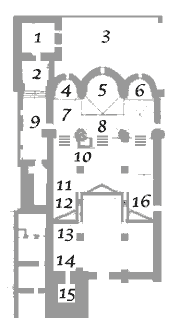|
10) The ambo rebuilt during the church's restoration under the guidance of Mr. Perrone. The symbols of the evangelists, retrived on the bell tower's wall, were part of the old ambo.
11) The canvas of the Deposition is the work of school of Perugino. It was donated to the parish.
12)The Dead Christ under the altar table shows Spanish influences; according to tradition, it belonged to a Spanish settlement in the place known as "Pian di Spagna" at the tip of Lake Como: during a flood of the Adda river is was swept away into the lake, some fishermen from Bellagio found it and put it up for adoration in their own church.
13) This is an "archaic crucifix" donated to the parish: but it has nothing to do with the complex of the church.
14) The Baptistry as it can be seen now, it's the result of several interventions that took place after the church was restored: the Venetian-school mosaic (see above) represents the Baptism of Christ of the canvas by Borgognone in the church of Melegnano; the basin's support is by the sculptor Daverio of Bergamo; the general arrangement as it appears today goes back to 1986
15)The bell tower. According to reliable sources, the lower par was built earlier than the church. It was one of the towers of the village's system of defenses toward the north. The church was built up against it and the tower, reaching just about to the roof of the church, was transformed to a bell tower (so says Ninguarda). In about 1700, when the church was transformed to a sixteenth century style, the bell tower was raised in the shape it has today and it was also plastered like the rest of the church. In 1990 it was restored as it is today.
16) The tryptic of he altar has image of Our Lady taken from the fresco attributed to Foppa. The figures of Saint Sebastian and Saint Rocco are a copy of the paintings by Foppa.
# - NOT OPEN TO THE PUBBLIC
|
